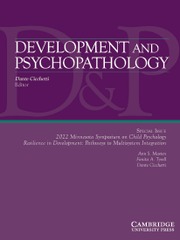Article contents
Developmental approaches to substance use and abuse
Published online by Cambridge University Press: 01 December 1999
Abstract
In 1996 the Institute of Medicine (IOM, 1996) issued a report on pathways to addiction.Although focused on the use of illegal drugs, the recommendations of the committee are equallyapplicable to more socially condoned, but still addictive, substances such as alcohol. The IOM(1996) report articulated the types of research that would be needed to expand the understandingof the etiology of drug use disorders, including the following: (a) multidisciplinary research toinvestigate the combined effects of biological, psychosocial, and contextual factors as they relateto the development of drug use, abuse, and dependence; (b) studies of sufficient duration toenable follow-up of participants in determining the role of risk and protective factors related tothe transition from drug use to abuse to dependence; (c) research investigating the role of familyfactors in the etiology of drug use and abuse; (d) examination of psychopathology as a precursorto drug use and abuse in adolescents and adults; (e) studies of risk and protective factors relatedto drug use and abuse, especially during discrete developmental stages; and (f) investigation ofchildhood risk and protective factors that are associated with drug abuse and dependence. Inreflecting on these comprehensive goals, striking similarities emerge with respect to theseresearch foci and the field of developmental psychopathology (Cicchetti & Cohen, 1995;Cicchetti & Toth, 1991). Specifically, the principles that guide inquiries conceptualizedwithin a developmental psychopathology framework can be applied toward the conduct ofstudies designed to address the agenda generated by the IOM (1996) report on substanceabuse.
Information
- Type
- Editorial
- Information
- Copyright
- © 1999 Cambridge University Press
- 15
- Cited by

